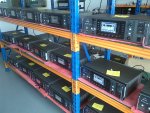Re: S16 audio drop outs
I can confirm that the Roland cable did not have metal heads on either end, although it did have ethercon connectors. This was 4 years ago though, things have probably changed with the stuff they currently ship. The wiring on the cable was not changed, so if it was wired to the "b" spec originally, then it still is.
We had the console on a UPS, but not the snakes. At this time we can't actually afford two more UPS units. Do you think it would be better to have the console on a UPS alone or have none of them be on UPS's? They definitely won't ever be on the same circuit.
The problem I have with all of this is that even when neither the mixer, nor the stage boxes was on a UPS, and we ran standard run of the mill cat5e cables, the Roland board has never had any drop outs or noise.
It doesn't exactly fill me with confidence to recommend the Behringer with it being so "picky" about its environment.
I don't think this is an "official problem". Many official and un-official folks have commented on this, and as far as I have read, only a few have reported having this as a problem. As far as I know, most have not followed ALL the recomendations summed up here:
1. Less than 300' total length between mixer and furthest s16 (actually less than 330' but anytime your pushing over 250, your Increasing your chance of trouble. KT just released a new ethernet/optical extender this year that supports aes50 @ 48k and 96k both now, that might be the thing best for long mission critical uses.
2. Use shielded STP cat-5 wired to the "b" spec, with metalized ends having the drain wire soldered to the metalized end on both ends. This Is really needed when running over 250' for sure! I use cat-6 because it holds up better with the plastic insulator running the length, it's stiffer, but more resistant to crush damage. I've had no problems with 100+ shows. The Roland cat-5 cable was mentioned, I'm a Roland dealer, that's a 328' cat-5 STP with soldered metalized ends. My question is: was the new end that was shortened by 2' wired to the "b" spec and also with a metalized end having drain wire properly soldered to it?
3. Use a UPS for the mixer and all s-16's that has either zero "switch over time" (constant voltage) or at MINIMUM use a UPS that will kick In in less than 20 milliseconds. If your ups does not state it's transfer switching time, then it is not good enough for this application. It's been tested by Behringer officially and any sag under 80v for more than 20ms will cause "wierdness". If your s-16's are too far away, get another "good" UPS with the same specs for those too. I don't think I ever heard anyone official say the s16's have to be on the same circuit or electrical phase, that should not matter as long as it has a good UPS. The digital converters in the S16's elliminate any buzz from differences in neutral/ground potential (buzz), between them and the mixer (as long as you stay all digital). The circuit/phase/panel would matter if different between the s16 and other s16's and/or amps/powered speakers for sure (hear: nasty buzz)!
Thanks!
I can confirm that the Roland cable did not have metal heads on either end, although it did have ethercon connectors. This was 4 years ago though, things have probably changed with the stuff they currently ship. The wiring on the cable was not changed, so if it was wired to the "b" spec originally, then it still is.
We had the console on a UPS, but not the snakes. At this time we can't actually afford two more UPS units. Do you think it would be better to have the console on a UPS alone or have none of them be on UPS's? They definitely won't ever be on the same circuit.
The problem I have with all of this is that even when neither the mixer, nor the stage boxes was on a UPS, and we ran standard run of the mill cat5e cables, the Roland board has never had any drop outs or noise.
It doesn't exactly fill me with confidence to recommend the Behringer with it being so "picky" about its environment.

